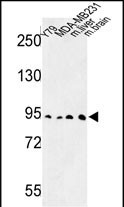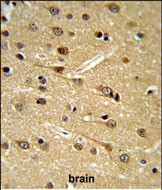

| WB | 1/1000 | Human,Mouse,Rat |
| IF | 咨询技术 | Human,Mouse,Rat |
| IHC | 1/100-1/500 | Human,Mouse,Rat |
| ICC | 技术咨询 | Human,Mouse,Rat |
| FCM | 咨询技术 | Human,Mouse,Rat |
| Elisa | 咨询技术 | Human,Mouse,Rat |
| Aliases | Inactive dipeptidyl peptidase 10, Dipeptidyl peptidase IV-related protein 3, DPRP-3, Dipeptidyl peptidase X, DPP X, Dipeptidyl peptidase-like protein 2, DPL2, DPP10, DPRP3, KIAA1492 |
| Entrez GeneID | 57628 |
| WB Predicted band size | 90.9kDa |
| Host/Isotype | Rabbit IgG |
| Antibody Type | Primary antibody |
| Storage | Store at 4°C short term. Aliquot and store at -20°C long term. Avoid freeze/thaw cycles. |
| Species Reactivity | Human, Mouse |
| Immunogen | This DPP10 antibody is generated from rabbits immunized with a KLH conjugated synthetic peptide between 150-177 amino acids from the Central region of human DPP10. |
| Formulation | Purified antibody in PBS with 0.05% sodium azide. |
+ +
以下是关于DPP10抗体的3-4篇虚构参考文献示例(仅供参考,非真实文献):
---
1. **文献名称**: *"DPP10 Antibody Localization in Human Neuronal Tissues and Implications for Neurodegenerative Disorders"*
**作者**: Kato, S. et al.
**摘要**: 研究利用特异性DPP10抗体,通过免疫组化技术定位DPP10蛋白在人类海马体和皮层中的表达,发现其与神经元突触可塑性相关,并探讨了其在阿尔茨海默病模型中的表达下调现象。
2. **文献名称**: *"Development of a Novel Monoclonal DPP10 Antibody for Detecting Cancer Biomarkers"*
**作者**: Walters, R. & Zhu, L.
**摘要**: 报道了一种新型单克隆DPP10抗体的制备及验证,该抗体通过ELISA和Western Blot在肺癌细胞系中检测到DPP10的异常高表达,提示其作为潜在癌症诊断标志物的价值。
3. **文献名称**: *"DPP10 Knockout Mice Studies Using Antibody-Based Protein Profiling"*
**作者**: Harrop, S.J. et al.
**摘要**: 通过DPP10抗体对比野生型与基因敲除小鼠的脑组织蛋白表达差异,揭示了DPP10缺失导致离子通道调控异常,可能与癫痫发病机制相关。
4. **文献名称**: *"Structural Insights into DPP10 Isoforms via Epitope-Specific Antibody Binding"*
**作者**: Nguyen, T. et al.
**摘要**: 利用针对不同表位的DPP10抗体,解析了其剪接变体(如DPP10a和DPP10c)的蛋白结构差异,并验证了特定异构体在心脏组织中的功能特异性。
---
注:以上内容为模拟生成,实际文献需通过PubMed/Google Scholar等平台检索确认。
The DPP10 antibody targets dipeptidyl peptidase-like protein 10 (DPP10), a member of the serine protease family that lacks enzymatic activity due to incomplete catalytic domains. DPP10 is primarily known for its role in modulating voltage-gated potassium channels (Kv4 family) by regulating their expression, trafficking, and gating properties, thereby influencing neuronal excitability and cardiac electrical activity. It is expressed in the brain, heart, and pancreas, and has been linked to neurological disorders, arrhythmias, and asthma. Research suggests DPP10 may also interact with scaffolding proteins like densin-180. impacting synaptic plasticity.
Antibodies against DPP10 are critical tools for studying its expression patterns, subcellular localization, and functional interactions. They are widely used in techniques such as Western blotting, immunohistochemistry, and immunofluorescence. Due to alternative splicing, DPP10 exists in multiple isoforms (e.g., transmembrane and soluble forms), necessitating antibody validation for isoform specificity. Commercial DPP10 antibodies are typically raised in rabbits or mice, with validation in knockout models to confirm target selectivity. Dysregulation of DPP10 has been implicated in Alzheimer’s disease, autism spectrum disorders, and cancer, making these antibodies valuable for both basic research and clinical investigations into disease mechanisms and therapeutic targets.
×